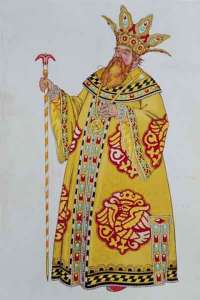(Skazka o Tsare Saltane)
Tale of Tsar Saltan is one of the most known fairy tales from Russian foklore. It inspired many artists, who created books, poems, illustrations, paintings, music and stage projects based on Tsar Saltan and other characters from this classic Russian fairy tale.
The Tale of the Tsar Saltan is sometimes also titled The Princess Swan, but we should not confuse it with The Swan Princess, successful movie based on the even more popular ballet The Swan Lake (which, by the way, is also partially based on Russian folk tales). It’s probably the best to provide some kind of …
Short summary of Tale of Tsar Saltan
In general we have two versions.
First was written in 19th century when dozens of scholars in Europe started to collect old stories, fables, fairy tales, legends and just about everything what might help to preserve cultural heritage in fast paced developing society where new norms were replacing traditions without much thought if everything old is really so bad to deserve being forgotten. The most famous collection of those times is of course known as Fairy Tales by brothers Grimm.
The second, and today more known version of the Tale of Tsar Saltan was written in 1831 by Alexander Sergeyevich Pushkin (1799-1837).
The basic plot is the same:
1. We have three sisters and Tsar Saltan who by accident hears what the talk about him. He marries the youngest and elder two are jealous at her.
2. When the youngest sister gives birth to kids, her sisters (or their helpers, depending on version) replaced them with puppies and with some additional scheming the young queen is sealed in a barrel together with her youngest son and thrown in the ocean.
3. The barrel strands on the shoe of uninhabited island and both survivors (with some magic help, which again differs in various versions) manage to build beautiful palace with complete infrastructure.
4. Traveling merchants see the palace, beautiful Queen Marfa and Prince Guidon, and tell about the miraculous happenings on the formerly uninhabited island to the Tsar Saltan.
5. Despite some additional obstacles (and more magic) he visits the island and finally finds the truth. All the lost sons are returned and we have a classic happy ending.
Let’s start our visual exploring with illustrations by Ivan Yakovlevich Bilibin (1876-1942), who made next set of illustrations for books (this fairy tale was published in different versions and on different occasions). You’ll recognize all the main scenes starting with a king listening at the doors right to the happy ending.
Bilibin also made scenery for the opera in four acts (plus prologue) and they are presented below together with a poster. Opera was written by Rimsky-Korsakov at Pushkin’s centenary (1899) and premiered in 1900.
Bilibin wasn’t the only artist who contributed to the scenery of the opera made after the tale of Tsar Saltan. Next paintings were made by Mikhail Aleksandrovich Vrubel (1856-1910) and there is even a photo of his wife Nadezhda Zabela Vrubel (1868-1913), famous opera singer, in the role of Swan Princess.
Last set of illustrations is done by Boris Zvorykin (1872-1942), who had similar artistic style, spent years in France, and loved similar folk motifs as Bilibin, but didn’t manage to achieve his fame due political problems. Now we can at least pay him some tribute with last five illustrations.
Other artists were inspired by the same tale and here are two more links to their works, first by Natalia Sergeevna Goncharevna (1881-1962) and second by Aleksander Mikhailovich Kurkin (1916-):
https://archive.org/details/contedetsarsalta00push
http://www.lib.ru/LITRA/PUSHKIN/saltan.txt
All presented images are in public domain and are edited by me. If you want to use one or more of them, a link to this post would be appreciated, and if you need one in higher resolution, just drop me a note, maybe I have it:)
I hope you enjoyed in the Tale of the Tsar Saltan!




































